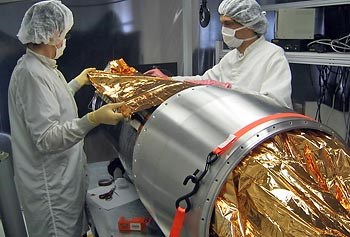Ultimate Goal Is to Discover Earth-like Worlds Around Sun-like Stars

Asst. Prof. Timothy Cook, right, and post-doctoral associate Christopher Mendillo prepare an earlier version of PICTURE, which was flown in 2011 aboard a sounding rocket.
12/01/2014
By Edwin L. Aguirre
The instrument — dubbed the Planetary Imaging Concept Testbed Using a Recoverable Experiment – Coronagraph, or PICTURE C — is scheduled to be launched on two separate flights, in the fall of 2017 and 2019, from the Columbia Scientific Balloon Facility in Fort Sumner, N.M., where it would be carried aloft to the edge of the atmosphere using helium balloons several stories tall.
“PICTURE C will enable us to learn about the disk of dust, asteroids, planets and other debris orbiting the stars and gain a better understanding of the processes and dynamics that formed our own solar system,” explains Chakrabarti, who is the principal investigator for the NASA study. “But in order for us to do this, we have to fly the instrument to altitudes of about 120,000 feet to get above most of the Earth’s atmosphere. Atmospheric turbulence distorts and blurs our image of the stars.”
Aside from Chakrabarti, the other members of the UMass Lowell team are physics Asst. Prof. Timothy Cook, who is the project’s co-investigator; graduate student Kuravi Hewawasam and post-doctoral associates Susanna Finn and Christopher Mendillo. Other collaborators include researchers from NASA’s Jet Propulsion Laboratory and Goddard Space Flight Center, Caltech, MIT, the Space Telescope Science Institute and the University of California Santa Barbara.
Employing Cutting-Edge Technologies
Five stars have been selected as test targets for the two missions, representing a wide range of brightnesses, ages, distances and spectral types: Alpha Lyrae (Vega), Sigma Draconis, Epsilon Eridani, Alpha Aquilae (Altair) and Tau Ceti.
The mission will allow PICTURE C to test its coronagraph, a specialized optical imaging system coupled to a 24-inch-diameter telescope designed to “mask,” or block out the direct light from the star so that faint objects very close to the star — such as planets, asteroids and interplanetary dust, which otherwise would be hidden in the star’s bright glare — can be studied in great detail.
The scientists expect the instrument to be rocked by turbulence in the upper atmosphere. To keep the coronagraph aimed precisely at the target, the instrument is mounted on a special gimbal platform in the balloon’s gondola that can compensate for any unwanted movements. PICTURE C will use the platform in conjunction with an onboard active optical pointing control system.
“Chris Mendillo designed and built this fine-pointing system and had validated it on an earlier mission,” notes Chakrabarti. “It can provide the coronagraph a pointing accuracy of 5 milliarcseconds, which is comparable to that of the Hubble Space Telescope, or even better.”
To the Threshold of Space
The researchers have also used sounding rockets to lift instruments weighing more than 1,000 pounds to altitudes of up to more than 900 miles above the ground. These rockets are not powerful enough to boost their payload to orbital speed — after scientific observations have been completed, the payload falls back to Earth, deploying a parachute to slow down its descent and allow for a safe recovery of the payload on the ground.
“Prof. Cook and I have a combined 40 years of experience launching experiments aboard sounding rockets, and we have successfully launched 20 of them during that time span,” says Chakrabarti.
For example, in November 2012 Cook launched another NASA-funded instrument, called IMAGER, aboard a sounding rocket to observe the spiral galaxy M101 and measure the properties of its dust. Cook and his team are now analyzing the data from the IMAGER flight to understand how ultraviolet light is absorbed by the dust, how it heats and destroys the dust and how new dust is formed.
Sounding rockets and high-altitude balloons offer a relatively inexpensive way to verify the flightworthiness of the science hardware before they are placed into orbit, which costs tens of millions of dollars per launch. However, scientific observations aboard sounding rockets are limited to about seven minutes or so before the rocket’s payload falls back to the ground.
“For some experiments, the several hundreds of seconds of data from above the atmosphere that a sounding rocket provides are just not enough,” explains Chakrabarti. “In the case of PICTURE C, a high-altitude balloon offers a better way to lift the instrument to the threshold of space — above 99 percent of the atmosphere — and keep it aloft for hours or days, depending on the weather conditions as well as the launch site, the type of balloon, the time of day, etc.”
At the end of the mission, ground controllers would send a command to release the payload from the balloon, and the payload free-falls to the ground. A parachute is then deployed to slow it down and allow the payload to land gently for reuse in the next mission.
“The flight of PICTURE C is going to be the first balloon mission for UMass Lowell,” says Chakrabarti.
A Brand-New Research Center
The NASA grant represents the first major funding received by the university’s new seed center, called the Lowell Center for Space Science and Technology (LoCSST). Directed by Chakrabarti and based in Wannalancit Mills on East Campus, LoCSST will conduct research to study Earth, other Earth-like exoplanets, the Milky Way galaxy and the cosmos.
“The center aims to train the next generation of scientists and engineers through hands-on involvement in all phases of the mission, from instrument development to data analysis,” says Chakrabarti. “We will also mentor and train early career professionals in space astronomy and engineering and promote hands-on undergraduate participation in space and technology research.”
